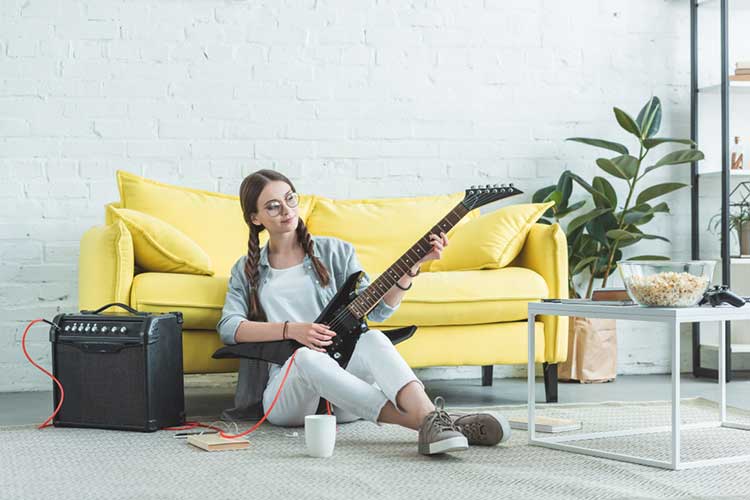How to Connect Electric Guitar to Bluetooth Speaker (Easy Guide)
If you’re looking for a great way to amp up your music-listening experience, connecting your electric guitar to a Bluetooth speaker is the way to go.
Not only will you be able to listen to your music with better sound quality, but you’ll also be able to rock out and jam along with your favorite songs.
In this blog post, we’ll explore each of these methods of connecting an electric guitar to Bluetooth speakers.

How to Connect Electric Guitar to Bluetooth Speaker
There are two main ways that you can connect your electric guitar to a Bluetooth speaker. One way is to use an amp. The other is to use a phone simulator app coupled with a phone adapter. Let’s discuss each method at a time.
Connect Electric Guitar to Bluetooth Speaker Using a Guitar Amp
- Plug the guitar cord into the guitar.
- Plug the other end of the cable into the INPUT jack on the guitar amp.
- Turn on the amp and set the volume to a low level. You can adjust this later.
- Plug the speaker cable into the OUTPUT jack on the amp.
- Plug the other end of the speaker cable into the speaker.
- Turn on the speaker and set the volume to the desired level.
- Turn on the guitar and adjust the tone and volume controls to a comfortable level.
- Strike a string on the guitar and listen for sound through the speaker.
Connect Electric Guitar to Bluetooth Speaker Using a Phone Simulator Amp
- Plug your electric guitar into the guitar-phone adapter with a guitar cable.
- Plug the guitar adapter into your phone or tablet using a headphone cable.
- Launch the guitar amp app of your choice.
- Turn on your Bluetooth speaker and ensure it’s in the correct audio settings.
- Connect the adapter with the Bluetooth speaker using an audio cable.
- Adjust the volume and settings on your guitar and amp simulator app to your preference, and start rocking out!
How to Connect Guitar to Speakers without Amp
There are a lot of reasons you might want to play your guitar through Bluetooth speakers without an actual or simulator amp. Maybe you’re at a party and don’t want to bring the amp. Or perhaps you’re trying to learn the guitar and don’t have an amp yet.
Whatever your reason, playing guitar without requiring an amp is a brilliant idea.
Here are the components you need:
- Headphone-guitar adapter
- Low latency transmitter
- Velcro tape
- Short headphone cable
On getting the above components, follow the steps below to connect your electric guitar with speakers without using an amp:
- Connect the headphone adapter to the 3.5mm input jack on the guitar.
- Connect the low latency Bluetooth transmitter to the headphone adapter with the short headphone cable.
- Attach the two components with Velcro tape.
- Turn on the Bluetooth transmitter and guitar.
- Pair the Bluetooth transmitter with your Bluetooth speakers.
- Adjust the volume on the guitar and Bluetooth transmitter.
- Enjoy your guitar music through the connected Bluetooth speakers!
How to Connect Electric Guitar to Receiver
There’s something about the sound of an electric guitar that just makes your heart race, doesn’t it? The notes pouring from the instrument seem to fill up the room and touch your soul. If you’ve ever felt that way, then you know why you need to connect an electric guitar to a receiver.
With a quality receiver, you can get the most out of your electric guitar. Here are the steps to follow to connect your electric guitar to a receiver:
- Pick an electric guitar receiver with enough power to amplify your guitar adequately. Make sure that your receiver has input for guitars.
- To plug in your guitar, you’ll need a guitar cable. Most electric guitars use a ¼” mono plug, so you will need a cable that has this type of connector on both ends.
- Plug the guitar cable into the output jack on the guitar. The output for guitars will be located somewhere on the bottom.
- Plug the other end of the cable into the IN jack on the amplifier or receiver.
- Turn on your receiver.
- Turn on the guitar by pressing down on the ON switch located on the upper-left side of the instrument.
- Adjust your guitar’s and receiver’s settings to get the sound you want.
- Play your favorite songs and enjoy the sound from the audio device connected to the receiver.
Do All Bluetooth Speakers Work With Electric Guitars?
If you’re doing a wired connection, then every Bluetooth speaker with an aux input will work with your electric guitar. However, only Bluetooth speakers that support low latency transmitters will work if it’s a wireless connection.
If you use a Bluetooth speaker that doesn’t support low latency transmission, then you’ll get a slight delay in the sound transmission (0.5 s to 1 minute). This can get annoying, especially when you continually play the electric guitar.
To sum it up, not all Bluetooth speakers are created equal, and some are better suited for guitar applications than others. So, before you make that purchase, ensure that the Bluetooth speaker is specifically made to work with the type of electric guitar you have.
The Bottom Line
If you’re like me, you probably love listening to guitar tunes with better audio quality and amplified sound. Now, with the help of a Bluetooth speaker, you can enjoy your favorite tunes this way, even without having to worry about being tethered to your guitar.
This article showed you how to connect your electric guitar to a Bluetooth speaker, so you can jam out wherever you want.